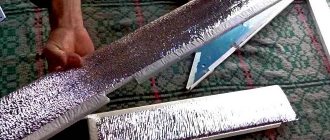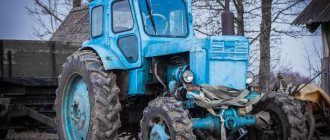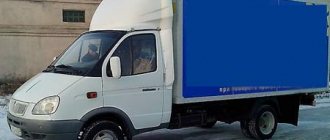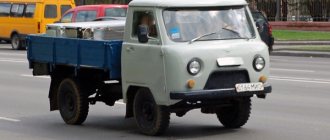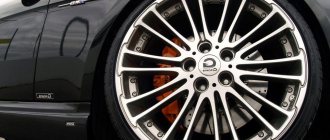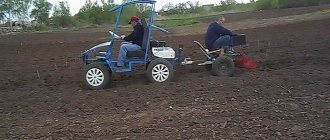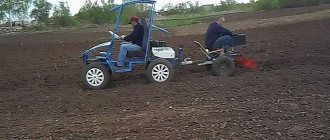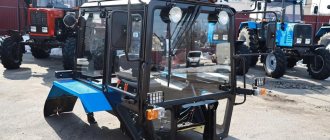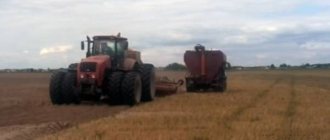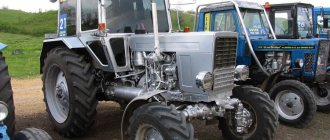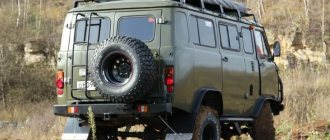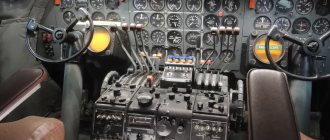By the 70s of the last century, it became obvious to progressive design engineers that the future lay in high-speed tractor units with increased power and the further evolution of tractor technology would go in this direction. Particular success in the development of this direction was made by the team of the Kharkov Tractor Plant named after Sergo Ordzhonikidze under the leadership of chief designer B.P. Kashuba.
In 1973, tractors of the T-150 type were accepted for mass production. A fundamentally new family of tractors was developed as a unified one, and the T-150 model existed in two modifications - tracked and wheeled. However, it was the wheeled model, the T-150K, that was especially popular. Its distinctive features: greater power, high productivity (2 times more compared to its predecessors), improved gearbox, and the ability to operate at high speeds (up to 15 km/h).
In total, the Kharkov Tractor Plant produced more than 753 thousand T-150K wheeled tractors and their modifications. The cars were successfully exported, raising the prestige of the country. In the USSR in the 70-80s of the last century, these powerful units became the first assistants in the countryside - they greatly improved working conditions and contributed to the rise of agriculture.
Predecessors
T-150K is not the first powerful wheeled tractor that was created at KhTZ.
Back in 1959, N. S. Khrushchev, after a trip to the USA, decided to “catch up and overtake” American farmers using wheeled tractors instead of tracked ones, and entrusted the development of a worthy competitor to the Kharkov tractor class=”aligncenter” width=”900″ height=”664 ″[/img] KhTZ Chief Engineer A. A. Soshnikov successfully completed this task. Under his leadership, a powerful wheeled tractor T-125 was created - a fundamentally new original model that has no analogues. It is believed that this tractor became the prototype of the T-150K. By the way, the T-125, like the T-150K, was a unified type vehicle, and it could be produced in a tracked version.
But still, we note that there was a fairly long gap between the release of the T-125 and T-150K models, during which the development of high-speed tracked tractors was carried out at the Kharkov plant. It was thanks to this experience that the T-150K was able to appear - the first powerful and high-speed wheeled tractor.
T-150+
=Brothers forever!
In general, I am a fan of supplementary rations and am constantly convinced that this consumable gives too much, a cheating increase. About a whole series of tanks I can say “TankN goes great with chocolate.” But none of the tanks I played on needed a 10% increase that much.
I really like, you know, poking around in the performance characteristics of a tank, trying to figure out by the numbers how to play this or that tank correctly - how to use the strengths/weaknesses. But in the case of the T-150, this did not fully help, the numbers show, of course, that additional ration cures a crooked gun like a plantain, but in practice it turned out like this:
- We play with an additional share. The turntables are flying with a bang. At short distances <100 meters, you start shooting steadily from semi-firing, but in contact combat - only spinners, only hardcore! Dogfights are our everything.
- We're taking off extra rations, since there are 20-30 of them left in the warehouse, and God knows when the next promotion for consumables will be. And this is where the fun begins. Misses, misses, misses. It seems that the accuracy is becoming like that of the KV-2. Pain-suffering-coffin-cemetery-smoked chair.
2 years later, I still remember my 982nd game on the Siegfried line, after which I sold the tank. “We’ve run out of extra rations - OK, no big deal, we’ll play like that. Imba!”
As a result, for ~10-12 shots from half-firing almost at point-blank range (well, you understand at what distances on the Siegfried line there is a firefight) -
level 0 .
All projectiles: misses/rolls without damage/ricochets. According to my feelings, I came to the conclusion that the crew on the T-150 are some real VIP-assholes, generals, their motherfucking sons. As soon as he took the goodies from them, the gunner immediately “Ohhh that’s it!! So is it possible to fight? I’m going on strike!”
There was a certain amount of my bad luck in such situations, and of course it was my own fault that I didn’t get it completely, I got used to how a tank is played on soldering. But still, over the course of a thousand games, I often alternated between playing with rations and an auto-suppressor, simply because:
Power plus speed...
The development of high-speed tractors was undertaken by the chief designer of KhTZ B.P. Kashuba. In particular, he created an experimental series of high-speed tracked tractors DT-54M. Together with the All-Russian Research Institute of Agricultural Mechanization, laboratory and field studies were carried out at high speeds (5-9 km/h). The tests were successful, proving that the path of modernizing tractors towards speed is quite promising.
HTZ began producing a series of high-speed tractors almost like hot cakes! 1960 - the first high-speed tracked tractor T-75 in the USSR, 1962 - T-74. The operation of these machines has shown that it is possible to further increase operating speeds and it is quite possible to create even faster models.
Mechanical Upgrade
The most popular methods of modernizing the mechanics of the T-150 tractor can be divided into stages:
- Improve the box. Many people increase third gear.
- Strengthen the grip. To do this, change the clutch basket and disc.
- Equipped with a wheel doubling kit. It will provide better traction because the contact area will be larger
- Considering that the tractor already has a turbocharger, you can increase the power by replacing the engine.
- Install the intercooler. This is a system for additional cooling of the air entering the cylinders.
- Change the equipment settings, i.e. increase the fuel supply. Diesel consumption will increase, but engine life will decrease.
- Install a hydraulic pump of higher capacity. This will further increase the tractor's lifting capacity.
...plus wheels!
Finally, in 1967, Kashuba turned to the chief engineer of KhTZ V.V. A book with a proposal to develop at the plant a fundamentally new model of a powerful high-speed caterpillar tractor. However, the chief engineer set his own condition: that the new tractor be unified - have the possibility of both tracked and wheeled modifications.
This was a real challenge, because creating a unified unit is much more difficult than creating a tracked or wheeled unit separately. Nevertheless, the plant, the team and the chief designer coped with this task! As a result, tractors like the T-150 were born. In 1973, the State Commission approved their serial production, and in 1974 a Resolution was adopted on the creation of capacities for their production.
The wheeled model has gained great popularity. The wheels made it possible to use the tractor not only in the fields, but also for road work: the T-150K is adapted for movement on highways.
Modernization of the T-150: do-it-yourself cabin tuning
The T-150 type tractor has 2 modifications - on tracks and wheels. The equipment is adapted for driving across fields and asphalt concrete roads. Its mass production began in 1973. 10 years later, the first tuned versions appeared. The owners of the tractor tried to stand out: they changed the braiding on the steering wheel, the interior trim, and installed mirrors of a different shape. Tuning the T-150 is still gaining popularity among customizers.
Tractor engine T-150K
Engine SMD-62, six-cylinder, four-stroke, turbocharged, diesel, 165 hp. (121.5 kW), with a crankshaft speed of 2100 rpm, was specially developed for the T-150K model. The engine cylinders are arranged in a V-shape with a camber angle of 90°. The cylinder bank houses the turbocharger and exhaust manifolds. Air is supplied to the cylinders by a turbocharger under excess pressure. Turbocharging increases the flow of air into the cylinders, which allows for increased power without increasing specific fuel consumption.
The fuel is injected by an injector into the combustion chamber, an open, toroidal, undivided type, located in the thick-walled piston crown. The toroidality of the piston ensures maximum air swirl. Direct injection of fuel into the combustion chamber (piston recess) makes it easier to start the engine and reduces specific fuel consumption.
The engine runs on diesel fuel. At air temperatures above 0 °C, use summer fuel, grades L or DL, at temperatures from 0 to -30 °C - winter fuel, grades 3 or DZ, at temperatures below -30 °C - arctic fuel, grades A or DA.
On the T-150K tractor, a two-stroke carburetor with crank-chamber purge starting engine P-350 with a power of 10 kW is installed on the flange of the diesel engine flywheel housing. The intake of the combustible mixture and the exhaust of exhaust gases is carried out through windows located in the engine cylinder, which are opened and closed by a piston.
Initial characteristics of the tractor
The unified T-150K should be special - this is what the developers decided and installed a diesel, four-pin engine equipped with 6 cylinders. Camber angle 60°. The exhaust manifolds and turbo compressor are also located there. When air enters the cylinder, the power increases, but the specific consumption of diesel fuel does not increase. Engine power - 165 hp. With. The gasoline engine in the original version was started by an electric starter. Later, the T-150 tractor was equipped with a YaMZ internal combustion engine.
| Characteristics of T-150 | Meaning |
| Weight | 8.1-8.75 t |
| Fuel tank volume | 430 l |
| Reverse speed range | 6.6-10.4 km/h |
| Forward speed range | 1.8-30.1 km/h |
| Traction characteristic | 3 tf |
The gearbox has 4 ranges:
- transport;
- delayed;
- reverse;
- worker.
Each allows you to engage 4 gears. There are shoe brakes on all wheels, and a band parking brake on the front axle shaft. The front and rear frames are connected by vertical and horizontal hinges.
Thanks to the reinforced base and wheels of identical size, the load capacity increases and it becomes possible to aggregate more equipment with the tractor.
Dimensions:
- length 0 6130 mm;
- width - 2400 mm;
- height - 3195 mm.
The T-150K cabin is specially equipped in the center of gravity area. This prevents vibration. The cabin is equipped with heating and ventilation systems. The operator is reliably protected from extraneous noise and dust. The cabin is two-seater, comfortable seats on springs are adjustable to the weight and height of the driver.
Other Features
The engine, together with the clutch and gearbox, is mounted on the tractor frame on four supports equipped with rubber-metal shock absorbers.
The T-150K has all driving wheels. The tractor is turned by the steering wheel using hydraulic cylinders acting on the articulated frame. Due to the “break” of the semi-frames in the horizontal plane, the tractor moves along a curved path.
The four-speed manual transmission, together with the clutch and engine, forms a common unit attached to the tractor frame on brackets and shock absorbers. The gearbox operates in several ranges (slow, working, transport and reverse), which are switched when the tractor stops. Gears are switched manually, without interrupting the power flow.
The T-150K has two brakes: central and wheel. The central handbrake is used for stopping in a parking lot. Wheeled is used to reduce the speed or completely stop a moving tractor.
Design features of tractors T-150 and T-150K
The T-150 tractor is equipped with a 6-cylinder 4-stroke engine, the nominal rotation speed of which is 2100 rpm. To start the internal combustion engine, the agricultural machine is equipped with 2 starters - an electric one, which is activated from the cab, and a manual one.
The supporting structure of the T-150 tractor in its standard configuration consists of two durable steel half-frames, which are connected by hinges in the horizontal and vertical planes.
A gearbox is attached to the tractor engine, as well as built-in output shafts. They are connected to reinforced final drives using integrated driveshafts. The control of the agricultural machine is carried out using standard hydraulic steel cylinders, which move the semi-frames in different directions in relation to the hinge.
The T-150 wheeled tractor is equipped with powerful pneumatic wheels with a deep aggressive tread pattern. Both pairs of model tires have the same diameter. This makes the economic unit more stable and passable when driving on loose and viscous soil.
Unlike the 150th modification, the T-150K tractor is equipped with a diesel internal combustion engine with a pre-installed turbocharger. Despite the reduced power, the motor shows high traction parameters, as well as the ability to successfully withstand increased and variable loads.
The T-150K tractor includes a mechanical transmission, gear shifting in which occurs under the action of hydraulic clutches. Thanks to this, switching the speeds of special equipment is carried out without the need to completely stop the unit. The tractor's factory gearbox is configured to operate in 4 modes.
Depending on the standard configuration, the T-150K agricultural machine can be equipped with a wheeled or tracked undercarriage. In the first case, the unit is intended for work in the field. The T-150K tracked tractor has better stability on uneven surfaces, so this modification is most often used as a bulldozer.
The T-150K tractor is equipped with a spacious 2-seater cabin, which houses the steering, linkage and PTO shift levers, as well as standard ventilation and heating systems. The cabin of the agricultural machine is distinguished by a high level of vibration and noise insulation, which makes working in it more convenient.
Cabin of the T-150K tractor
The cabin of the T-150K tractor is a special pride of the designers! Never before has it been so comfortable and convenient. The tractor driver in it could feel like a real king.
The spacious (for two seats) all-metal sound- and dust-insulated sealed cabin is equipped with a ventilation and heating system, equipped with a sun visor, a first aid kit, rear-view mirrors and glass cleaners. There are even hooks for clothes and a thermos for drinking water! The driver's seat is sprung and adjustable depending on the weight and height of the driver.
How to tune the cabin with your own hands
Instead of the usual headlights, you can install halogen ones, instead of signal beacons - flashing lights and stroboscopes. This technique will definitely attract attention. The color of the case may be different: blue, red, yellow. Some add metallic shades.
Tinting will help protect against ultraviolet radiation.
But experts recommend high-quality athermal film. It is more expensive than the usual black one, but when taking measurements with “TONIC” it gives an acceptable percentage of light transmission. In the sun it shimmers with all the colors of the rainbow. An additional effect is provided by blue lighting in the hubcaps (preferably from MAZ) and running boards. If you install KAMAZ brake lights, the appearance of the body will change. Additionally, the state number is highlighted.
You can arrange a stylish interior by decorating the dashboard with reptile skin inserts, and replacing the fabric upholstery on the seat with fur or leather.
It is recommended to cover the door and ceiling with carpet. This material stretches well, practically does not tear, and creates an additional soundproofing effect. It is easy to glue it to the surface with your own hands using PVA glue. Black and beige carpet looks the most advantageous.
Handbrake decor is an integral part of tuning. It wouldn’t hurt to laminate it with carbon, which is carbon fiber consisting of tiny polymers. The same technology is used to modernize door handles.
The large-scale dashboard leaves room for imagination. It will fit a radio, DVD with a high-precision monitor, and a subwoofer. It is important to install 3 antennas: for radio, television and walkie-talkie. During relaxation, the cabin will turn into a cinema or karaoke bar.
Some people place LED strips on the walls and ceiling. It changes colors depending on the selected mode. You can connect using the remote control.
After tuning, it is recommended to coordinate changes in the design with the State Traffic Inspectorate. Otherwise, tuning the cab can be expensive for the owner of the T-150 tractor. It is unlikely that protocols and fines will be avoided.
World Star
The T-150K truly turned out to be a tractor of a fundamentally new class, not only in its powerful technical parameters, but also in design and level of comfort for the driver. Sealed comfortable cabins, a sprung tractor driver's seat, light and comfortable steering, transmissions with gear shifting on the fly, stable heavy-duty tires - all this was noted not only by domestic but also foreign experts, and the T-150K successfully entered the world market.
From 1973 to 1977, the tractor received five gold awards at international exhibitions! In 1979, during tests in the USA (International Tractor Test Site, Nebraska), the T-150K developed a thrust that was almost equal to its weight, and the Americans immediately dubbed it a tractor that can lift itself.
In 1980, the creator of the revolutionary unit, the Kharkov Tractor Plant, received the international Golden Mercury award for peace and cooperation. Thanks to the worldwide recognition of the T-150K, KhTZ has significantly increased its exports. From 1976 to 1990, 21,863 such models were delivered to the USA, Canada, Australia, Europe, Asia and Africa.
Modifications
There are three main types of this tractor. The T-150KS1 is equipped with a hydraulic attachment system, an independent power take-off shaft, a trailing shackle and a harness, a PZHB-300 preheater, a hydraulic hook, an evaporative air cooler and a breakaway coupling with hoses.
The T-150KS2 is equipped in the same way as the T-150KS1, but without the rear linkage, power cylinder with hoses, PTO, hydraulic hook and pre-heater.
T-150KSZ is a tractor with a hydraulic traction hook. It is equipped in the same way as the T-150KS1, but without a towing bracket and harness, PTO and pre-heater (a breakaway coupling with hoses is included with the tractor).
Numerous modifications were created on the basis of the T-150 family of tractors: the T-156 loader, the T-150D and T-150DK bulldozers, the T-155 military engineering tractor, the T-158 and T-157 industrial and forestry tractors, the ESVM-7 chemical treatment machine and etc.
Subscribe to our Telegram channel
Modifications of tractors T-150 and T-150K
Since their release, the T-150 and T-150K models have gained wide popularity among users. This allowed the machine manufacturing company to create several more units, the basis of which was the 150th modification.
The list of tractors produced on the basis of the T-150 and T-150K includes:
- T-158 is a model intended exclusively for work in industry. The unit received a more powerful engine, a reinforced supporting frame and a linkage mechanism that allows you to install drills, buckets, loaders and other implements on the tractor;
- T-155 is a tractor with small physical dimensions. The modification is equipped with a wheeled chassis with two drive axles. The increased traction parameters of the motor made it possible to make the unit a universal modification, which is often used for transporting large-sized solid and bulk cargo in quarries and factories;
- T-157 – skidder tractor. The machine is designed specifically for logging work. The unit received an improved articulated suspension, which allowed its chassis to change position not only in the horizontal, but also in the vertical plane;
- T-156 is a medium-sized loader. The main advantages of the model are low fuel consumption and improved transmission. The unit has a simplified design, which allows you to quickly repair it yourself;
- T-150KD is a tractor, the design of which allows you to install different types of bulldozer equipment on the machine. The machine stands out for its increased durability and maneuverability on soft surfaces.
The T-150 tractor also served as the basis for the creation of the army version of the T-154, which today is actively used for towing artillery installations, as well as for performing various engineering and construction work. All spare parts of this modification are made of reinforced metal alloys, which made it less vulnerable in real combat conditions. The main difference between the model and other tractors is the hook, which replaced the standard pendulum hitch mechanism.
